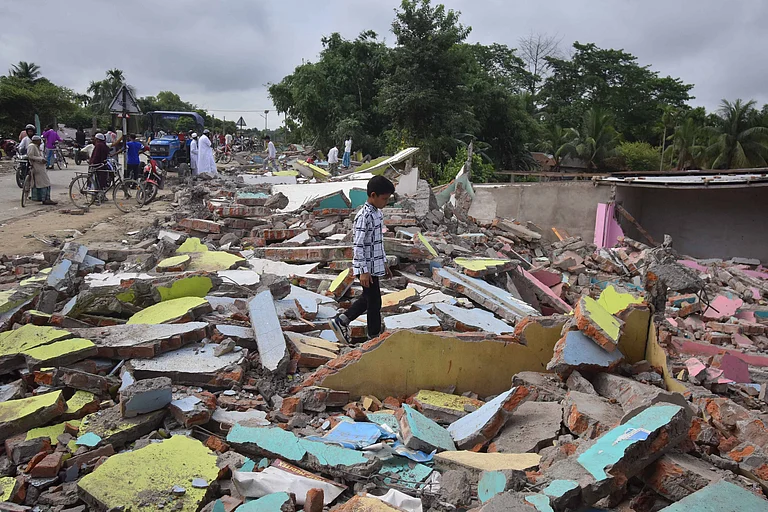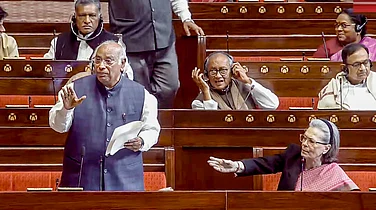“You want to know how we live in a relief camp? Come stay with us for a couple of nights and see for yourself,” said Mainul Haque, 41, to Outlook, while leaning against a bamboo post of his makeshift house in Dhalpur of Darrang district. Last December, Mainul lost his mother Noitan Nesa. Two months later he lost his elder brother Khush Mamud. All of them had been living together in a makeshift hut alongside the Brahmaputra.
“They died due to cold. They were suffering from pneumonia. I could not take them to the hospital on time because we can no longer use the short route to the town hospital we used to take, as it goes through the government project. I somehow took them to hospital by a very long route, but in both cases, doctors declared them brought dead.”
Mainul’s family was one of the 1,400 evicted last September by the Assam government to clear land for an agriculture project to generate employment for ‘indigenous locals’. All those families were Muslims of Bengali origin. But to the Assam government, they are illegal settlers.
The eviction grabbed media attention because of the degree of brutality the Assam Police used, to evict the settlers. It gunned down two during eviction including a 12-year-old boy.
In the Dhalpur area, to the south of the Brahmaputra, the Assam government allotted some land for the evicted families to stay temporarily. To the north of the river, on the eviction site, the ambitious agricultural Gorukhuti Project is coming up. It's set up in the same place where the community used to grow millets, rice, jute etc. The agrarian community wasn't even allowed to harvest the produce by the district administration, which burnt the farms to clear the site in September last year. At least 3,000 people are living on the temporary plot now.
The state government has resettled some families who were residing at the site of the agricultural project, but those evicted from surrounding areas continue to live in relief camps.
When we say ‘relief camp’, it is to be noted that only a specific plot has been allotted by the government, not any structure where people can take shelter. The families have built makeshift huts with whatever material they could recover from the eviction site. Drinking water facilities, toilets, and health care are distant dreams.
Reports say, at least 10 people, including three children, died in the Dhalpur relief camp due to one of the hardest winters the state has experienced.
In another district of Hojai in Central Assam, in three relief camps, at least 3,000 people have been living for the past five months, after they were evicted from the Lumding Reserve Forest in November last year.
According to government data, 737 families have been evicted from 1,410 hectares of land. Apart from Muslims, these people include Garos and Chakmas.
While the Assam government has allotted half bigha of land to each family of Garos, a tribe indigenous to the Northeast, Muslims and Chakmas are not yet provided permanent settlements.

Reportedly, in the three camps of Nakhuti, Dekabasti and Changmajhi, two newborn babies died right after birth, a pregnant lady died on the way to the hospital, three children got severely burnt after falling in boiling lentil pots and one lady suffered from over 70 per cent burns when flames caught one of those makeshift walls made of plastic sheets while she was cooking.
Talking to Outlook, Monwar Hussain, chief adviser of All Assam Minority Students Union (AAMSU), Hojai district committee, said, “There is a huge problem in rehabilitating these people, because the two constituencies --- Doboka and Lumding -- where the relief camps are located, are Hindu dominated. For political representatives, if Muslims are rehabilitated in the area, voters will abandon them. Also, the Chakma community has citizenship issues. So rehabilitating these people will be very tough.”
In 1974, when Kaziranga was declared a national park, it had an area of 430 sq km. Since 1977, 10 additions were made to the park for wildlife conservation, tackling human-animal conflict and flood mitigation. In addition, a huge number of people living on its fringes were evicted. The current landmass of the park is 1,090.5 sq km.
The villagers who were evicted comprise Adivasis, Muslims and tribals.
It has been accused that the government’s approach towards indigenous communities is somewhat “softer” than what it is towards Muslims. While the government arranged land for resettlement before evicting the Adivasis and tribals living in forest areas, Muslims were evicted without prior rehabilitation plans.

In September 2016, two people --- Fakruddin and Anjuma Khatun (18) -- died in police firing in the Banderdubi area of Nagaon district in a clash with police during a drive carried out by the administration to evict 205 families. The victims of eviction were protesters demanding resettlement initiatives and compensation from the administration.
The drive was a result of a Gauhati High Court order in which Mrinal Saikia, now a BJP MLA, in 2012, filed a PIL seeking eviction of illegal migrants in the buffer zone, accusing them of engaging in poaching and killing of wild animals.
Talking to Outlook, Hamid Ali, paternal uncle of late Anjuma Khatun, a college student who died in the police firing, said, “The eviction drive was carried out to oust illegal migrants but all of these people who got evicted have their names in the National Register of Citizens. No one has gone to a detention camp yet. Bandordubi is a revenue village with people having valid land documents who have been paying taxes to the government. Land documents as old as 1929 can be found with these families.”
Along with Bandordubi, two more villages --- Deo Surang and Palkhowa --- were evicted to extend Kaziranga's buffer zone. Deo Surang and Palkhowa were dominated by tribal communities. Before evicting these villages, the government already had a plan on where to resettle them or for compensation.
The worst part is many families living along the fringes of Kaziranga National Park have been experiencing multiple displacements due to the arbitrary extension of the park.
The worst victims of evictions without resettlement are women and girls. Thirteen-year-old Amina Khatun (name changed), who has been living in the Nakhuti relief camp in Hojai district, said, “I wake up before the sunrise. Not because I study, but because I need to take a bath before the men get up. We don’t have bathrooms. Plastic sheets are pasted in four posts to make a bathroom like structure where men and women, girls all take baths. I feel shy. Menstruating days are the worst. I feel like hiding somewhere when I don’t know where to dispose of clothes that I use in those days.”
According to student leader Monwar Hussain, women and children in these relief camps have become vulnerable to trafficking.
“Bengali-speaking Muslims are a peasant community. Now that they no longer have land for farming, the men in the family have shifted to towns and cities to earn a living as daily wagers. Many youths have gone out of state to work as security guards. Now there are traffickers who visit these camps to lure girls to go with them promising jobs. We are keeping an eye on these camps, but for how long?” Hussain said.


























